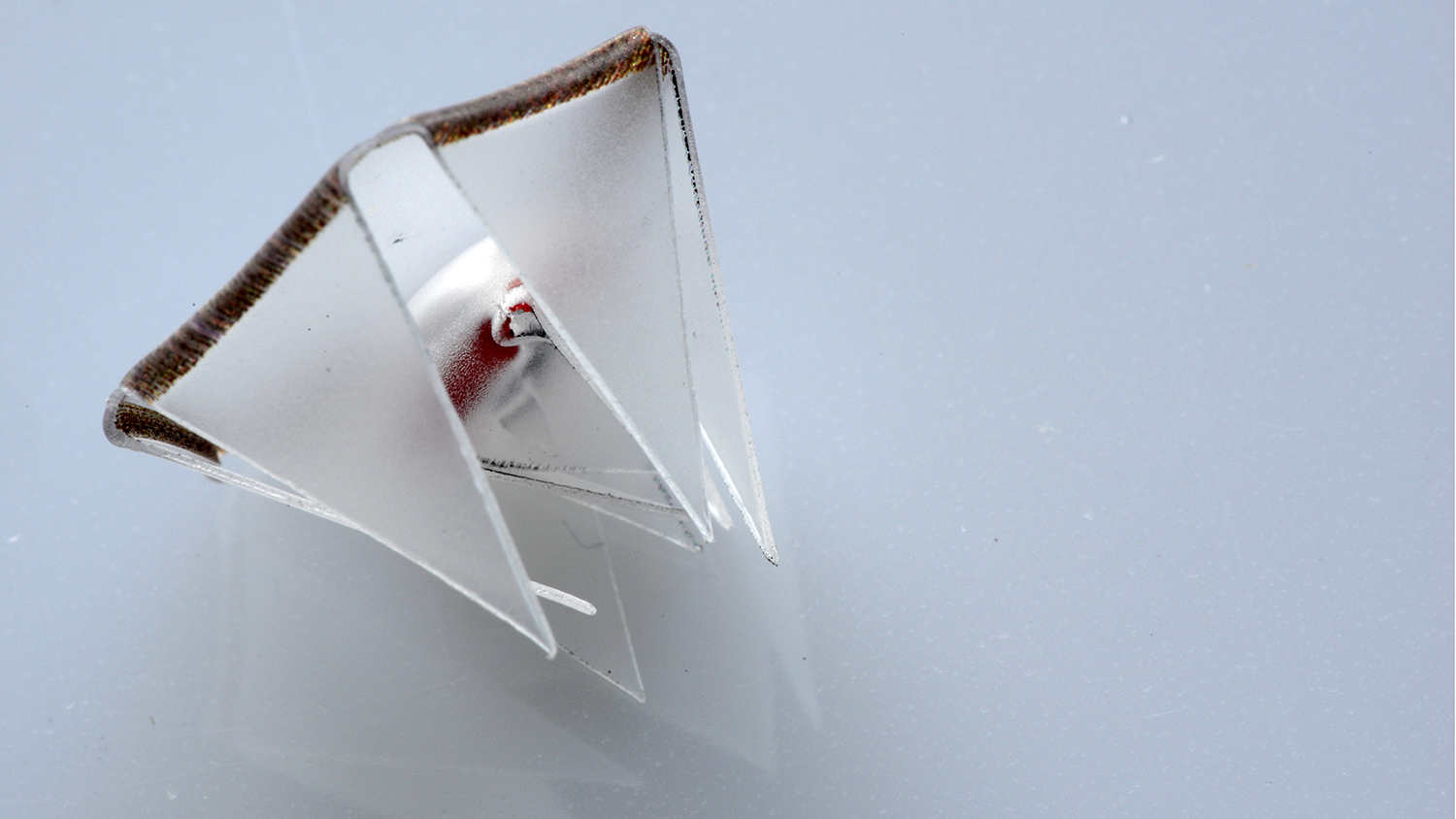Researchers Remotely Control Sequence in Which 2-D Sheets Fold Into 3-D Structures

For Immediate Release
Inspired by origami, North Carolina State University researchers have found a way to remotely control the order in which a two-dimensional (2-D) sheet folds itself into a three-dimensional (3-D) structure.
“A longstanding challenge in the field has been finding a way to control the sequence in which a 2-D sheet will fold itself into a 3-D object,” says Michael Dickey, a professor of chemical and biomolecular engineering at NC State and co-corresponding author of a paper describing the work. “And as anyone who has done origami – or folded their laundry – can tell you, the order in which you make the folds can be extremely important.”
“The sequence of folding is important in life as well as in technology,” says co-corresponding author Jan Genzer, the S. Frank and Doris Culberson Distinguished Professor of Chemical and Biomolecular Engineering at NC State. “On small length scales, sequential folding via molecular machinery enables DNA to pack efficiently into chromosomes and assists proteins to adopt a functional conformation. On large length scales, sequential folding via motors helps solar panels in satellites and space shuttles unfold in space. The advance of the current work is to induce materials to fold sequentially using only light.”
Specifically, the researchers have developed a technique to design and fabricate 2-D materials that can be controlled remotely in order to trigger any of the given folds to take place, in any order.
Dickey and Genzer were early leaders in the field of self-folding 3-D structures. In their landmark 2011 paper, the researchers outlined a technique in which a pre-stressed plastic sheet was run through a conventional inkjet printer to print bold black lines on the material. The material was then cut into a desired pattern and placed under an infrared light, such as a heat lamp.
The printed lines absorbed more energy than the rest of the material, causing the plastic to contract – creating a hinge that folded the sheets into 3-D shapes. By varying the width of the printed lines, or hinges, the researchers were able to change how far – and how quickly – each hinge folds. The technique is compatible with commercial printing techniques, such as screen printing, roll-to-roll printing, and inkjet printing, that are inexpensive and high-throughput but inherently 2-D.
The new advance uses essentially the same technique, but takes advantage of the fact that different colors of ink absorb different wavelengths, or colors, of light.
“By printing the hinges in different colors, we can control the order of the folds by altering the wavelengths of light that shines on the 2-D sheet,” Genzer says.
For example, if one hinge is printed in yellow and another hinge is printed in blue, the researchers can make the yellow hinge fold by exposing it to blue light. The blue hinge won’t fold, because blue ink doesn’t absorb blue light. The researchers can then make the blue hinge fold by exposing the sheet to red light.
In addition, by manipulating the colors of ink, the researchers were also able to get hinges to fold sequentially when exposed to a single wavelength of light. This is possible because some colors will absorb a given wavelength of light more efficiently than others. [Note: a video of the sequential folding techniques in action can be seen at https://youtu.be/ZlZOdiwbZIE.]
“This is a proof-of-concept paper, but it opens the door to a range of potential applications using a simple and inexpensive process,” Dickey says.
“Ultimately, people are interested in self-assembling structures for multiple reasons, from shipping things in a flat package and having them assemble on site to having devices self-assemble in ‘clean’ environments for medical or electronic applications.”
The paper, “Sequential Self-folding of Polymer Sheets,” is published in the AAAS journal Science Advances. Lead author of the paper is Ying Liu, a postdoctoral researcher at NC State. The paper was co-authored by Brandi Shaw, who participated in the work while an undergraduate at NC State. The work was done with support from EFRI program through the National Science Foundation, under grant number 1240438.
-shipman-
Note to Editors: The study abstract follows.
“Sequential Self-folding of Polymer Sheets”
Authors: Ying Liu, Brandi Shaw, Michael D. Dickey and Jan Genzer, North Carolina State University
Published: March 3, Science Advances
Abstract: Shape plays an important role in defining the function of materials, particularly those found in Nature. Several strategies exist to program materials to change from one shape to another; however, few can control the shape temporally and spatially. Programming the sequence of shape transformation with temporal control has been driven by the desire to generate complex shapes with high yield and to create multiple shapes from the same starting material. This paper demonstrates a remarkably simple strategy for programmed self-folding 2-D polymer sheets into 3-D objects in a sequential manner using external light. Printed ink on the surface of the polymer sheets absorbs light discriminately based on the wavelength of the light and the color of the ink that defines the hinge about which the sheet folds. The absorbed light heats the underlying polymer gradually across the thickness of the sheet, which causes relief of strain to induce folding. These color patterns can be designed to absorb only specific wavelengths of light (or to absorb differently at the same wavelength using color hues), thereby providing control of sheet folding with respect to time and space. This type of shape programming may find numerous applications including reconfigurable electronics, actuators, sensors, implantable devices, smart packaging, and deployable structures.
- Categories:


